Causes and treatment of mosaic on cucumbers: we fight the disease effectively and prevent its occurrence
You can buy cucumbers at any time of the year in almost every store or market. However, a vegetable grown by our own hands is much sweeter and more aromatic.
What to do if spots appear on its leaves, the plant withers, and the fruits lose their appearance and taste? Most likely a mosaic infestation has occurred and urgent action should be taken. Find out which ones in our article.
The content of the article
What is this disease
Mosaic is a viral disease that affects tissues at the cellular level... Chloroplasts are damaged and chlorophyll is destroyed. At the same time, the processes of photosynthesis and the formation of nutrients are inhibited. Sections of tissue die off, the plant dies.
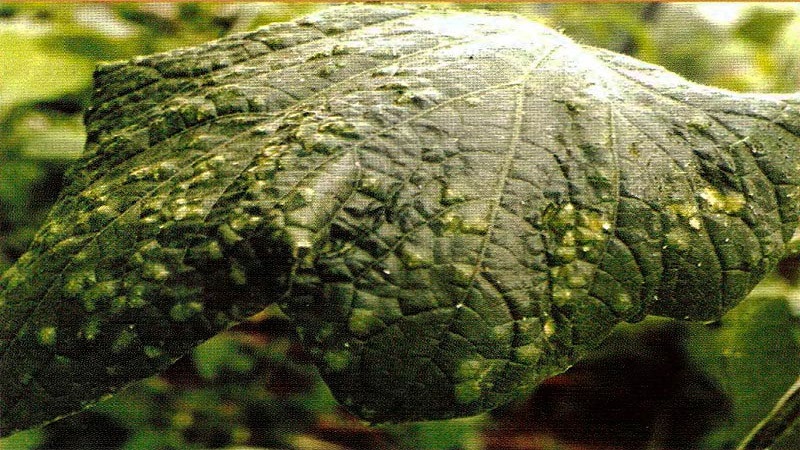
The pathogen attacks many plants: cucumbers, tomatoes, cabbage, peppers, tobacco and others.
For reference... The virus remains viable in soil for decades.
How is it manifested on cucumbers
Mosaicity can be diagnosed by light (white or yellow) spots on the leaves... Over time, the affected leaf plates deform and dry out. Certain types of mosaics cause dark green streaks on the tops.
The virus also infects the fetus: Cucumbers are crooked, stained and bitter.
What is dangerous
Mosaic viruses are not dangerous to humans... The harm lies in partial or complete loss of yield due to the pathogen.
Spread and persistence of infection endangers the well-being of healthy plants and future plantings.
Read also:
Why does gray rot appear on cucumbers and how to deal with it
Mosaic types
There are several types of mosaics... The most common are tobacco, common, green speckled and white.
Attention!Several types of mosaic disease can develop on one plant at once.
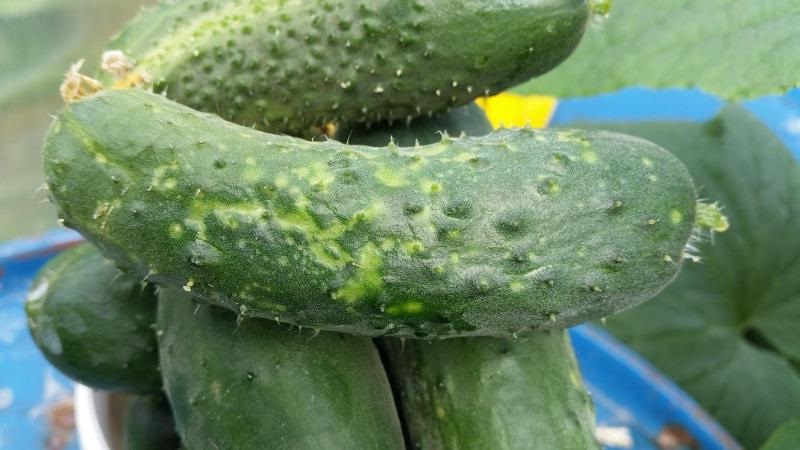
Tobacco
Tobacco mosaic is more susceptible to tobacco, tomatoes, peppers. Cucumbers rarely become infected.
The causative agent of this disease is the tobacco mosaic virus (TMV) - was one of the first to open.
Disease symptoms:
- beige stains forming a mosaic pattern on the leaves;
- the green parts of the leaf plate are swollen, bumpy;
- wilting and dying off of foliage with the development of the disease;
- underdeveloped, ugly fruit.
Ordinary
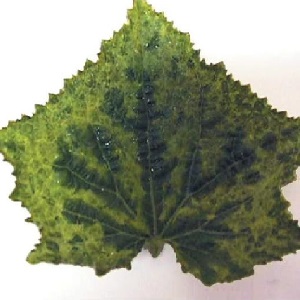 Cucumber mosaic virus (CMV) leads to the appearance of ordinary mosaic... In addition to cucumbers, this variety affects tomatoes, beans, cabbage.
Cucumber mosaic virus (CMV) leads to the appearance of ordinary mosaic... In addition to cucumbers, this variety affects tomatoes, beans, cabbage.
Signs of CMV on Cucumbers:
- dark green and light green areas randomly located on the leaves;
- folded down edges of the sheet plate;
- cracks at the base of the stem;
- shortened internodes;
- fallen flowers;
- speckled, wrinkled, twisted fruits.
The common mosaic virus dies at a temperature of 60-70 ° C within 10 minutes. It is not transmitted through cucumber seeds.
Green speckled
Another name for the disease is the English cucumber mosaic.
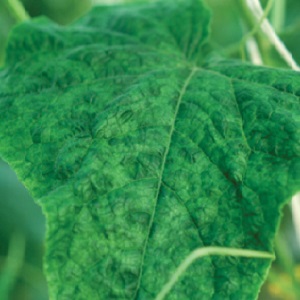 Pathogen - Cucumber Green Speckled Mosaic Virus (WMCV), or Cucumber green mottle mosaic virus (CGMMV). Attacks only plants of the pumpkin family.
Pathogen - Cucumber Green Speckled Mosaic Virus (WMCV), or Cucumber green mottle mosaic virus (CGMMV). Attacks only plants of the pumpkin family.
Most often develops indoors... Both seedlings and adult plants are infected.
Symptoms appear after a sharp rise in temperature to 30 ° C:
- leaves become wrinkled;
- veins acquire a light shade;
- plants wither quickly;
- the cucumbers are covered with mosaic spots.
The pathogen CGMMV is resistant to heating up to 90 ° C, freezing, drying.
White
White mosaic often accompanies green speckled and is caused by the Cucumis virus 2A (CV2A).
A favorable environment for the development of the disease becomes a combination of warm air in greenhouses and thickening of plantings.
Signs of white mosaic:
- small yellow spots near the veins;
- spots in the form of rings or stars of greenish-white color;
- white leaves due to the confluence of spots;
- slow growth.
The virus persists in soil and seeds.
Causes of occurrence
The mosaic virus may not appear for a long time. Favorable conditions are required for activation.
Conditions for development
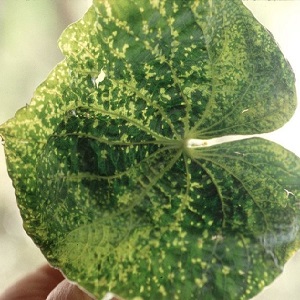 The pathogen begins to develop on weakened plants:
The pathogen begins to develop on weakened plants:
- Sudden changes in temperature - decrease to 13 ° С, increase to 30-32 ° С - negatively affect the growth and health of plants.
- Lack of moisture deprives the superficial root system of cucumbers of nutrients. Excessive watering without loosening leads to the formation of crusts on the soil surface and a lack of oxygen at the roots.
- Lack of minerals (potassium, magnesium, phosphorus) reduces immunity to infectious diseases.
- Dry air in greenhouses forces plants to actively evaporate moisture, which leads to an imbalance of salts in the tissues.
All of the above leads to stress. and reducing the resistance of the vegetable.
It will be interesting:
How to grow cucumbers on the balcony and get a harvest
How to grow a cucumber for seeds and collect seed
How does cucumber juice affect the body: benefits and harms, application
Sources of infection
Vegetables are infected in several ways.:
- using contaminated seeds;
- contact with infected plants or plant debris;
- spread by pests - carriers of the virus (aphids, thrips, ticks);
- from weeds, in the roots of which the infection persists;
- landing in contaminated soil.
Cucumber mosaic treatment
It is impossible to cure a plant from a mosaic, you can only localize the development of the disease.
At the first sign of infection remove affected leaves and shoots and burn them off-site. The tool is disinfected with boiling water, alcohol or a solution of potassium permanganate.
Important!There are no specific antiviral drugs for plants, viruses are not sensitive to pesticides.
With minor damage (up to 20% foliage) you can treat the area with a weak solution of potassium permanganate. At the initial stage, the development of the disease is stopped by spraying with a solution of milk whey diluted with water in a ratio of 1:10, with the addition of 15 drops of pharmaceutical iodine per 10 liters of the mixture.
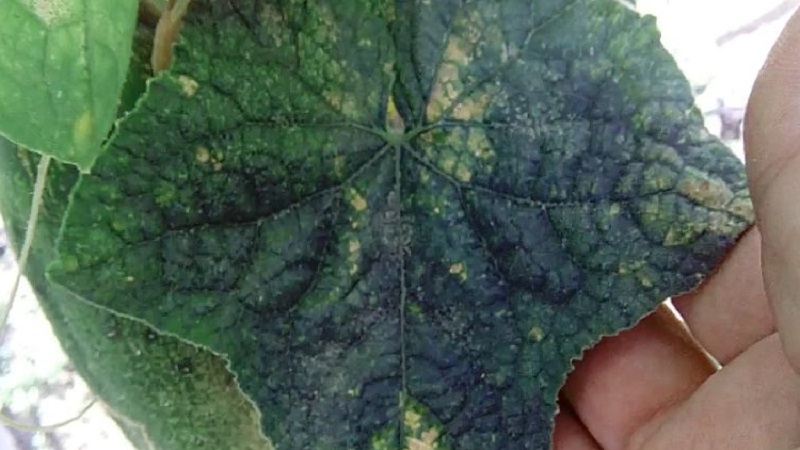
To reduce the risk of proliferation infestation on healthy plants, insecticides can be used that destroy vector pests.
Comfortable conditions for plants should be restored: optimum humidity, watering mode. It is useful to feed with microfertilizers.
In advanced cases, with extensive infection, the plants are destroyed: burned in the area where they grew. So it is disinfected by fire and soil.
Preventive measures
The main fight against mosaics is prevention. The following measures will help protect the site from disease:
- Crop rotation prevents the accumulation of viruses in the soil. The cucumbers should be returned to their original place no earlier than two years later.
- Disinfection of seeds. Before planting, you need to soak them in a 1% solution of potassium permanganate for 50 minutes.
- Annual replacement of the top layer of soil (10-12 cm) in greenhouses.
- Weeding and removing all plant residues from the site. The roots of perennial weeds retain viruses in winter.
- Timely destruction of pests (aphids, ticks, thrips and others).
- Do not thicken the planting. For 1 sq. m it is recommended to plant no more than four plants.
- Disinfection of garden tools after picking seedlings, pinching, etc.
- Regular abundant watering and feeding.

Useful Tips
A few tips and tricks from experienced gardeners will help you fight cucumber mosaic disease:
- Plant disease-resistant varieties and hybrids such as Thumbnail Boy f1, Masha f1, Pasadena f1, Cucumber f1;
- To maintain an optimal microclimate in the greenhouse, arrange several buckets of water. In the daytime, the evaporation of water will maintain the desired humidity, while at night the temperature drops, the liquid will give up the accumulated heat;
- use the water-based drug "Pharmayod" for the prevention of diseases. To prepare the working solution, take 1 teaspoon of the product in 1 liter of water. Treat plants, greenhouse structures, garden tools.
Conclusion
Mosaic disease is a serious threat to cucumbers. In advanced cases, you can lose the entire crop. Various types of virus cause tobacco, common, green speckled or white mosaic. The disease is manifested by light spots and deformation of the leaves. The fruits lose their presentation and become bitter.
There are no special means against the mosaic virus, so the fight is reduced to prevention. It is important to maintain cleanliness on the site, weed and remove plant debris in time, timely destroy pests and create comfortable conditions for the growth of vegetables. In the case of extensive lesions, only complete destruction of the plants helps.